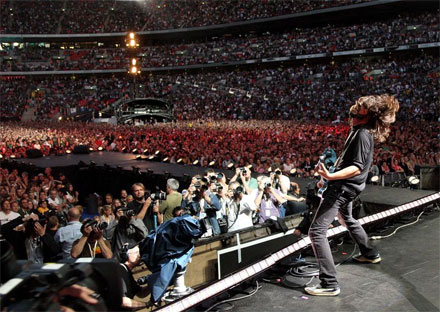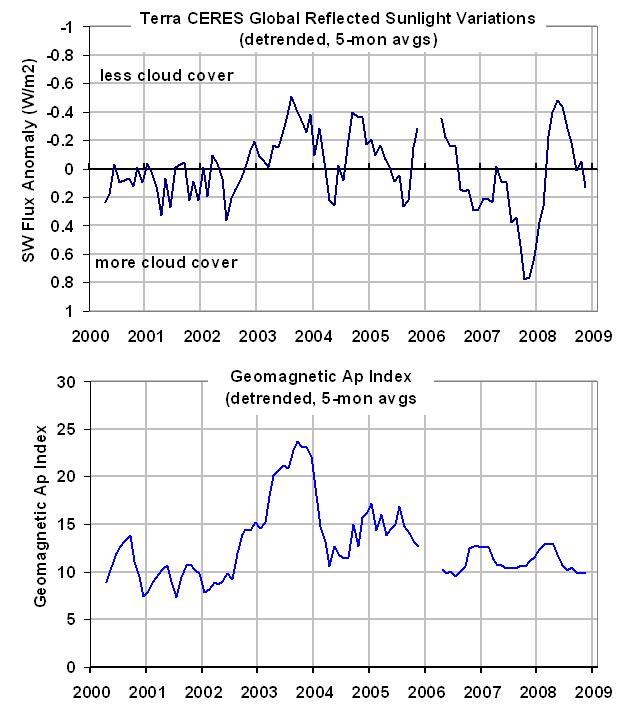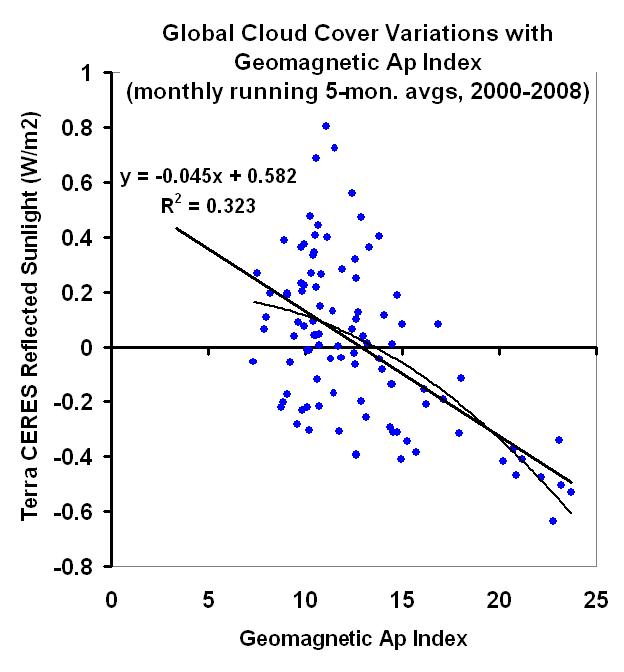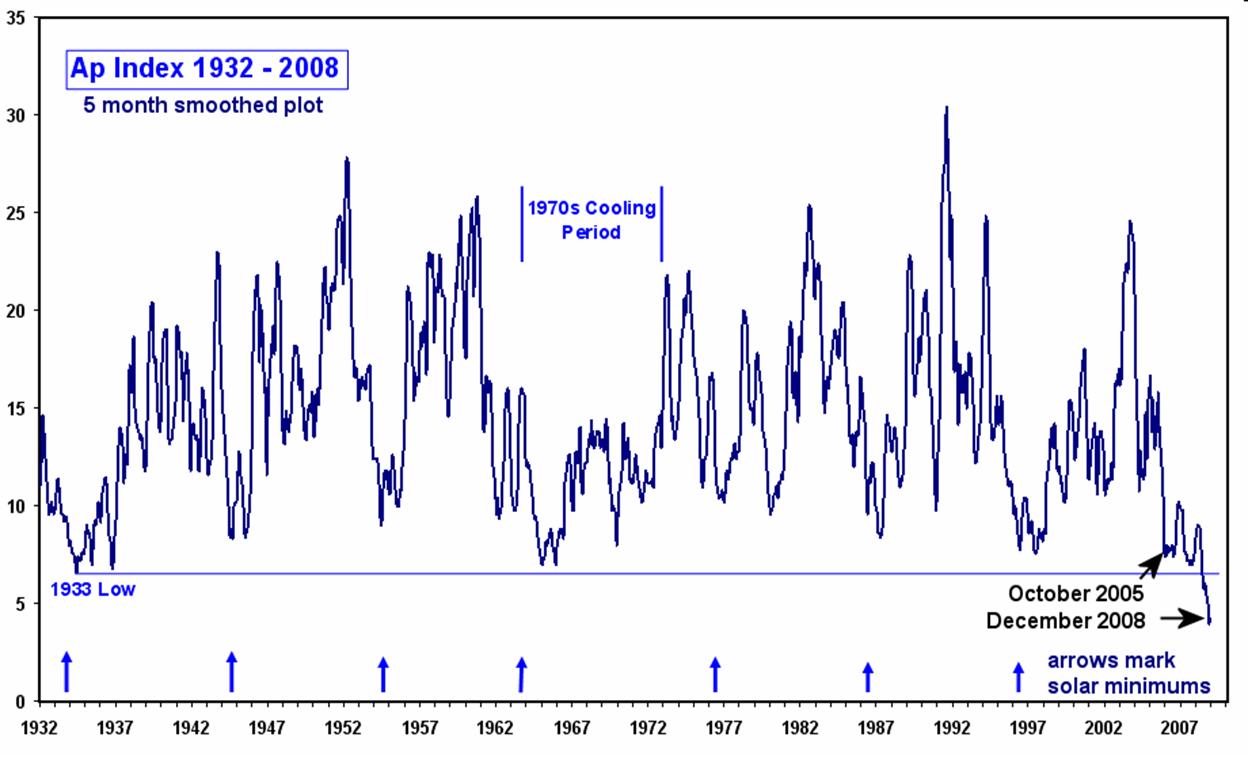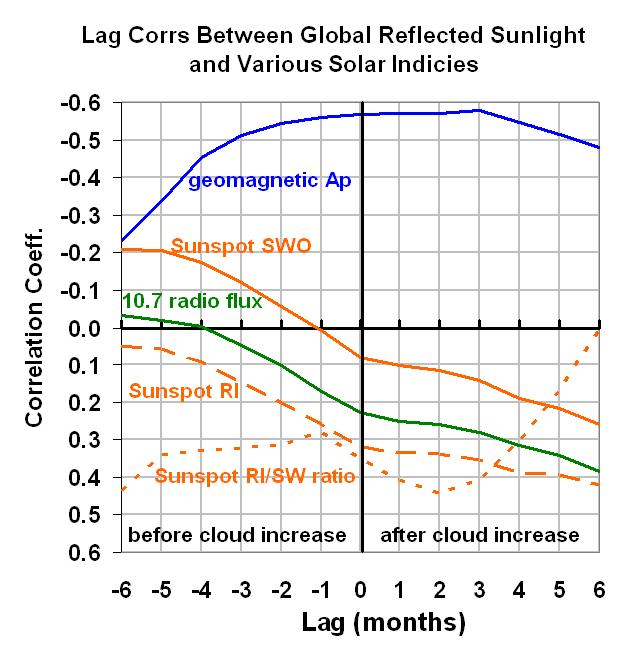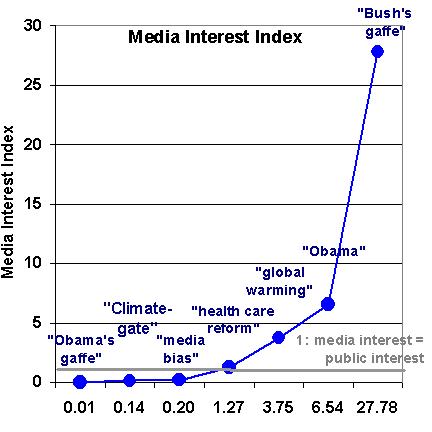(edited 1 p.m. Dec. 31, 2009, to mention latent heat release)
The climate of the Earth is profoundly affected by two competing processes: the greenhouse effect, which acts to warm the lower atmosphere and cool the upper atmosphere, and atmospheric convection (thermals, clouds, precipitation) which does just the opposite: cools the lower atmosphere and warms the upper atmosphere.
To better understand why this happens, it is an instructive thought experiment to ask the question: What if there was no greenhouse effect? In other words, what if there were no infrared absorbers such as water vapor and carbon dioxide in the atmosphere?
While we usually only discuss the greenhouse effect in the context of global warming (that is, the theory that adding more carbon dioxide to the atmosphere will lead to higher temperatures in the lower atmosphere), it turns out that the greenhouse effect has a more fundamental role: there would be no weather on Earth without the greenhouse effect.
First, the big picture: The Earth surface is warmed by sunlight, and the surface and atmosphere together cool by infrared radiation back to outer space. And just as a pot of water warming on the stove will stop warming when the rate of energy gained by the pot from the stove equals the rate of energy loss by the pot to its surroundings, an initially cold Earth would stop warming when the rate at which solar energy is absorbed equals the rate at which infrared energy is lost by the whole Earth-atmosphere system to space.
So, let’s imagine an extremely cold Earth and atmosphere, without any water vapor, carbon dioxide, methane or any other greenhouse gases – and with no surface water to evaporate and create atmospheric water vapor, either. Next, imagine the sun starts to warm the surface of the Earth. As the surface temperature rises, it begins to give off more infrared energy to outer space in response.
That’s the Earth’s surface. But what would happen to the atmosphere at the same time? The cold air in contact with the warming ground would also begin to warm by thermal conduction. Convective air currents would transport this heat upward, gradually warming the atmosphere from the bottom up. Importantly, this ‘dry convection’ will result in a vertical temperature profile that falls off by 9.8 deg. C for every kilometer rise in altitude, which is the so-called ‘adiabatic lapse rate’. This is because rising warm air parcels cool as they expand at the lower air pressures aloft, and the air that sinks in response to all of that rising air must warm at the same rate by compression.
Eventually, the surface and lower atmosphere would warm until the rate at which infrared energy is lost by the Earth’s surface to space would equal the rate at which sunlight is absorbed by the surface, and the whole system would settle into a fairly repeatable day-night cycle of the surface heating (and lower atmosphere convecting) during the day, and the surface cooling (and a shallow layer of air in contact with it) during the night.
The global-average temperature at which this occurs would depend a lot on how reflective the Earth’s surface is to sunlight in our thought experiment. ..it could be anywhere from well below 0 deg F for a partially reflective Earth to about 45 deg. F for a totally black Earth.
So, how is this different from what happens in the real world? Well, notice that what we are left with in this thought experiment is an atmosphere that is heated from below by the ground absorbing sunlight, but the atmosphere has no way of cooling…except in a very shallow layer right next to the ground where it can cool by conduction at night.
Why is this lack of an atmospheric cooling mechanism important? Because in our thought experiment we now have an atmosphere whose upper layers are colder than the surface and lower atmosphere. And what happens when there is a temperature difference in a material? Heat flows by thermal conduction, which would then gradually warm the upper atmosphere to reduce that temperature difference. The process would be slow, because the thermal conductivity of air is quite low. But eventually, the entire atmosphere would reach a constant temperature with height.
Only the surface and a shallow layer of air next to the surface would go through a day-night cycle of heating and cooling. The rest of the atmosphere would be at approximately the same temperature as the average surface temperature. And without a falloff of temperature with height in the atmosphere of at least 10 deg. C per kilometer, all atmospheric convection would stop.
Since it is the convective overturning of the atmosphere that causes most of what we recognize as ‘weather’, most weather activity on Earth would stop, too. Atmospheric convective overturning is what causes clouds and rainfall. In the tropics, it occurs in relatively small and strongly overturning thunderstorm-type weather systems.
At higher latitudes, that convection occurs in much larger but more weakly overturning cloud and precipitation systems associated with low pressure areas.
There would probably still be some horizontal wind flows associated with the fact that the poles would still be cooler than the tropics, and the day-night heating cycle that moves around the Earth each day. But for the most part, most of what we call ‘weather’ would not occur. The same is true even if there was surface water and water vapor…but if we were able to somehow ‘turn off’ the greenhouse effect of water vapor. Eventually, the atmosphere would still become ‘isothermal’, with a roughly constant temperature with height.
Why would this occur? Infrared absorbers like water vapor and carbon dioxide provide an additional heating mechanism for the atmosphere. But at least as important is the fact that, since infrared absorbers are also infrared emitters, the presence of greenhouse gases allow the atmosphere — not just the surface — to cool to outer space.
When you pile all of the layers of greenhouse gases in the atmosphere on top of one another, they form a sort of radiative blanket, heating the lower layers and cooling the upper layers. (For those of you who have heard claims that the greenhouse effect is physically impossible, see my article here. There is a common misconception that the rate at which a layer absorbs IR energy must equal the rate at which it loses IR energy, which in general is not true.)
Without the convective air currents to transport excess heat from the lower atmosphere to the upper atmosphere, the greenhouse effect by itself would make the surface of the Earth unbearably hot, and the upper atmosphere (at altitudes where where jets fly) very much colder than it really is.
Thus, it is the greenhouse effect that continuously de-stabilizes the atmosphere, ‘trying’ to create a temperature profile that the atmosphere cannot sustain, which then causes all different kinds of weather as the atmosphere convectively overturns. Thus, the greenhouse effect is actually required to explain why weather occurs.
This is what makes water such an amazing substance. It cools the Earth’s surface when it evaporates, it warms the upper atmosphere when it re-condenses to form precipitation, it warms the lower atmosphere through the greenhouse effect, and it cools the upper atmosphere by emitting infrared radiation to outer space (also part of the greenhouse effect process). These heating and cooling processes are continuously interacting, with each limiting the influence of the other.
As Dick Lindzen alluded to back in 1990, while everyone seems to understand that the greenhouse effect warms the Earth’s surface, few people are aware of the fact that weather processes greatly limit that warming. And one very real possibility is that the 1 deg. C direct warming effect of doubling our atmospheric CO2 concentration by late in this century will be mitigated by the cooling effects of weather to a value closer to 0.5 deg. C or so (about 1 deg. F.) This is much less than is being predicted by the UN’s Intergovernmental Panel on Climate Change or by NASA’s James Hansen, who believe that weather changes will amplify, rather than reduce, that warming.

 Home/Blog
Home/Blog